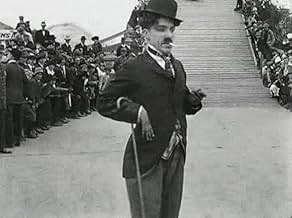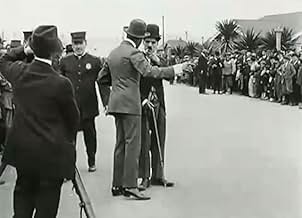AVALIAÇÃO DA IMDb
5,7/10
3,5 mil
SUA AVALIAÇÃO
Adicionar um enredo no seu idiomaThe Tramp wanders into and disrupts the filming of a go-kart race.The Tramp wanders into and disrupts the filming of a go-kart race.The Tramp wanders into and disrupts the filming of a go-kart race.
- Direção
- Roteiristas
- Artistas
- Prêmios
- 1 vitória no total
- Direção
- Roteiristas
- Elenco e equipe completos
- Produção, bilheteria e muito mais no IMDbPro
Avaliações em destaque
Tramp's first appearance and... he's a punk. Fun and meta at first, at least in the way that it's a movie about movie-making at a time when that was a fresh idea, but wears out its welcome as it's a one-note gag. There's not really any of Chaplin's great comically timed physical gags, it's just him being an a-hole getting in the way of a camera crew as they try to get footage of cars racing by. I wish there was more to it as Chaplin clearly already owns the role, but there's none of the charm or innocence yet. Guess these things would take time to alter, though unlike, say, Mickey Mouse's early appearances (comparing to iconic comic figures of the early 20th century), being an ass doesn't suit the Tramp so well, at least not to this extent (if maybe he'd just interacted with another character or built upon something that'd be one thing).
The Keystone period of Chaplin's work (1914) always suffers in comparison to his later films, especially the Mutuals and First Nationals. This is because he was still learning his craft, but mostly because Mack Sennett kept making the same film over and over again. While the majority of Keystones are indistinguishable from one another, this short subject, only Charlie's second, towers above the others. Here Chaplin attends an actual event in Venice (California) as a spectator pretending to be unaware that he is constantly getting in the cameraman's frame. Time has been positively affectionate to this film; appearing on camera is now a national pastime, and being a split reel it clocks in at about the same length as a Saturday Night Live skit. This film deserves your attention. It won't take long.
English stage pantomimist Charlie Chaplin, who had just signed a year's contract with Keystone Studios, was disappointed in his movie debut. He was told by studio head Mack Sennett to improve his screen presence or he would break his contract. On a rainy afternoon waiting to rehearse for his next movie, February 1914's "Mabel's Strange Predicament," Chaplin spied on several costumes hanging and laying around in the Keystone dressing room. He began trying on several pieces of clothing, including a small bowler hat, a tight-fitting jacket, baggy pants, oversized shoes, and a fake mustache to make him look older than his youthful 24-year-old face.
His role in "Mabel's" was to play a vagabond drunk hanging out in a hotel lobby. Recalling vaudeville tramps who appeared on the English stage such as Lew Bloom, Chaplin admitted he drew inspiration from the British comic magazine's two tramp characters as well.
For "Mabel's Strange Predicament," actress Mabel Normand assumed directing duties while Sennett looked over her shoulder examining on set Chaplin's performance. The studio head couldn't have been as critical of Chaplin's screen presence as he was after his initial film since the new actor, upon reviews from the press, drew accolades such as "we do not think we are taking a great risk in prophesying that in six months Chaplin will rank as one of the most popular screen performers in the world."
The public's first view of Chaplin's vagabond role appeared a few days earlier from "Mabel's" premier when his "Kid Auto Races In Venice" was shown, even though the later was filmed shortly after "Mabel's." Since the editing was minimal in "Kid Auto," Keystone Studio was able to release it before the more involved "Mabel's." Shot during Venice, California's Junior Vanderbilt Cup races, "Kid Auto" was filmed within a 45-minute period where Chaplin is seen hogging a camera's view intending to record the sporting event. Henry Lehrman, who directed the one-reeler, plays the cameraman who physically attempts to get Chaplin out of the way. Like a Monty Python skit, the Keystone Studio camera is recording another movie camera and operator recording an event, likely the first movie in cinema to do so.
Chaplin also drew praise in his role as a tramp wanting attention in "Kid Auto." As one movie reviewer wrote, "Chaplin is a born screen comedian; he does things we have never seen done on the screen before."
Chaplin's tramp character would evolve through the many years the actor assumed his character. From "Mabel's Strange Predicament" initial drunken role to a caring but down-on-his-luck everyman during the Depression Era, Chaplin's on-screen personality would personify what many had experienced during those trying times. Chaplin portrayed the tramp in 25 of his 36 films he made for Keystone during his first year, and he continued to do so through his next 30 years on the screen.
His role in "Mabel's" was to play a vagabond drunk hanging out in a hotel lobby. Recalling vaudeville tramps who appeared on the English stage such as Lew Bloom, Chaplin admitted he drew inspiration from the British comic magazine's two tramp characters as well.
For "Mabel's Strange Predicament," actress Mabel Normand assumed directing duties while Sennett looked over her shoulder examining on set Chaplin's performance. The studio head couldn't have been as critical of Chaplin's screen presence as he was after his initial film since the new actor, upon reviews from the press, drew accolades such as "we do not think we are taking a great risk in prophesying that in six months Chaplin will rank as one of the most popular screen performers in the world."
The public's first view of Chaplin's vagabond role appeared a few days earlier from "Mabel's" premier when his "Kid Auto Races In Venice" was shown, even though the later was filmed shortly after "Mabel's." Since the editing was minimal in "Kid Auto," Keystone Studio was able to release it before the more involved "Mabel's." Shot during Venice, California's Junior Vanderbilt Cup races, "Kid Auto" was filmed within a 45-minute period where Chaplin is seen hogging a camera's view intending to record the sporting event. Henry Lehrman, who directed the one-reeler, plays the cameraman who physically attempts to get Chaplin out of the way. Like a Monty Python skit, the Keystone Studio camera is recording another movie camera and operator recording an event, likely the first movie in cinema to do so.
Chaplin also drew praise in his role as a tramp wanting attention in "Kid Auto." As one movie reviewer wrote, "Chaplin is a born screen comedian; he does things we have never seen done on the screen before."
Chaplin's tramp character would evolve through the many years the actor assumed his character. From "Mabel's Strange Predicament" initial drunken role to a caring but down-on-his-luck everyman during the Depression Era, Chaplin's on-screen personality would personify what many had experienced during those trying times. Chaplin portrayed the tramp in 25 of his 36 films he made for Keystone during his first year, and he continued to do so through his next 30 years on the screen.
In 1914 Charlie Chaplin debuted with the Mack Sennett shorts for Keystone. These shorts were made in rapid succession and while some are great, some are ok (like this one) and some are bad. Despite the results they were all released in theaters. These early shorts are pretty much like home videos (like the ones played on AMERICA'S FUNNIEST VIDEOS) with people that do stupid things and in the end they have pratfalls. His tramp character (that debuted here) was still evolving as he switched to Essenay studios a year later. He stopped this evolution process with his full-length movies in the 1920s.
In this short, as I said in the summary, there isn't much plot. The Keystone crew went on a kid auto race and they told Chaplin to just wander around and coming in and out of the track. The only thing that happens beside this is that he is sometimes punched by few adults for getting in the track. The only thing for which this short is important is because we have a first shot of Chaplin's most famous character.
In this short, as I said in the summary, there isn't much plot. The Keystone crew went on a kid auto race and they told Chaplin to just wander around and coming in and out of the track. The only thing that happens beside this is that he is sometimes punched by few adults for getting in the track. The only thing for which this short is important is because we have a first shot of Chaplin's most famous character.
Kid Auto Races at Venice is far from Chaplin's best moment on film, but it might be his most important. In an early combination of the reality short subjects that dominated early cinema, and fictional comedy, this short piece features Chaplin as a tramp who annoys several camera crews at a car race.
As the first appearance of Chaplin's Tramp character, this film's place in movie history is secure. As a comedy, it's mildly amusing. Obviously ad libbed, it has an amateurish quality that holds up surprisingly well. It also provides a few thrills as Chaplin is nearly hit by the vehicles several times -- I doubt any of the near-misses were scripted!
There is no denying that this short film is not an example of Chaplin's best work on film, but every serious Chaplin fan, or cinema historian, needs to see it at least once.
As the first appearance of Chaplin's Tramp character, this film's place in movie history is secure. As a comedy, it's mildly amusing. Obviously ad libbed, it has an amateurish quality that holds up surprisingly well. It also provides a few thrills as Chaplin is nearly hit by the vehicles several times -- I doubt any of the near-misses were scripted!
There is no denying that this short film is not an example of Chaplin's best work on film, but every serious Chaplin fan, or cinema historian, needs to see it at least once.
Você sabia?
- CuriosidadesThis was the first film in which Charles Chaplin played his most famous character, The Tramp. With only a small number of exceptions, Chaplin would play only The Tramp (or slight variations on the character) on film until O Grande Ditador (1940).
- ConexõesEdited into Os Reis da Comédia (1960)
Principais escolhas
Faça login para avaliar e ver a lista de recomendações personalizadas
Detalhes
- Data de lançamento
- País de origem
- Centrais de atendimento oficiais
- Idiomas
- Também conhecido como
- Kid Auto Races at Venice
- Locações de filme
- 1300 Main Street, Los Angeles, Califórnia, EUA(intersection where filming took place)
- Empresa de produção
- Consulte mais créditos da empresa na IMDbPro
- Tempo de duração
- 11 min
- Cor
- Mixagem de som
- Proporção
- 1.33 : 1
Contribua para esta página
Sugerir uma alteração ou adicionar conteúdo ausente






















